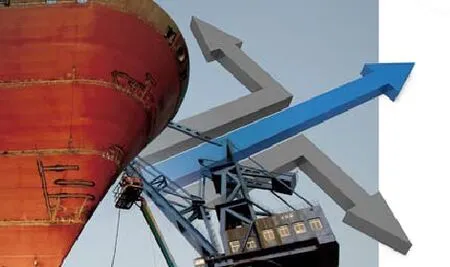The New Pattern of Shipbuilding Industry
Reporter Xu Hua
The shipbuilding industry is volatile. Chinese bulk carriers and Korean offshore engineering are in poor condition. However, Japan is turning around the corner in terms of orders for ships.The ranking of the three shipbuilding countries is changing. It is reported that in the fi rst half of this year,under the condition of orders for new buildings having suffered severe reduction, the South Korean yards is performing well and has obtained large amounts of newbuilding orders, defeating its competitors in Japan and China and took the first place in global newbuilding orders after three years, followed by Japan and China. South Korea experienced nightmare in marine engineering and returned to traditional shipbuilding market. What"s the reason for South Korea to grab the first place so easily? The disadvantage of bulk carriers being the main business has restricted the development of Chinese shipbuilding industry from the very beginning, but why the transformation has taken such a long time?
It is well known that bulk carrier has made Chinese shipbuilding industry successful, and in 2011 it made the three major index of Chinese shipbuilding overtake South Korea to land the title of top major shipbuilding nation. With advancement of the green standards and the rise of the oil price, energy-ef fi cient bulk carriers are very popular. During the year of 2013 and the fi rst half of 2014, orders for bulk curriers obtained by Chinese yards are prevalent. Though the price couldn"t be compared with 2008 and before, this is already a very good situation in the downturn period. However,the unstoppable BDI crash at the end of 2014 indicated the end of bulk carrier era. In the first half of 2015,there were very few bulk carrier orders, and in certain months, there were even no orders. Chinese ship building industry is suffering dystocia, and the other two big shipbuilding countries are also suffering the same.
Why the South Korean shipyards that were not in favor of orders for traditional ships in the last few years came back?
The three South Korean shipyards had no other choice but to return to traditional ship building market. It is reported that these three ship building magnates have failed and suffered huge losses in oil drilling platform market in which they had invested heavily. In the past year, Daewoo Shipbuiding & Marine Engineering,Samsung Heavy Industries and Hyundai Heavy Industries have lost a total of 8 trillion KRW(about 45.7 billion RMB) in the market of drilling platform. Once the news was released, the Korean stock market reacted immediately and the three magnates caused stock price slump. Experts pointed out that the lack of independent design capability of the three major shipyards has resulted in bad budget management, which led to the cost far exceed the expectation.
Though the loss is huge, the three big shipyards did not give up offshore engineering construction considering the past investment and the future prospect. However,collapse in price has resulted in less upstream investment. Major shipyards are restarting merchant ship construction with bittersweet minds and have turned around the corner via traditional shipbuilding business.
The Japanese shipyards have covered a long distance,with small but quick steps, having experienced frequent climax in orders. In 2014, Japan overtook South Korea three times and was in the second place.In Jan. of 2015, Japan came to the top position in terms of the number of monthly order for the first time since Mar. of 2008, reaching 991 thousand CGT(14 ships).

The Japanese shipbuilding industry for once didn"t wait for the downturn caused by the loss of cost advantage and did nothing. After several dozens of years of struggle, the yards survived pay more attention to “quality” rather than “quantity”. The 30 yards left from the 100 ones at the time of prosperity which have gone through the temporary pain have learned the secret of survival. In the first place,standardization, ships are nearly constructed in a standardized way. Everything goes in order and step by step; in the second place, concentration, most shipyards concentrate on ship types and designs they are familiar with, and do not change according to the preference of ship owners or give up the longterm goal because of the sudden short-term growth of the market; in the third place, confidence, shipyards are confident with their own products after years of experience, they are also familiar with the shipping market and the industry; obstinacy, shipyards persist in their own designs and manufacture, once the specification is signed, especially when the design is completed and the construction stage has begun, the yards are reluctant to change the design, and the cost of changes for shipowners is huge; efficiency, under the premise of safeguarding quality, construction schedule and efficiency, generally, the process can be completed according to the schedule set in the contract.

